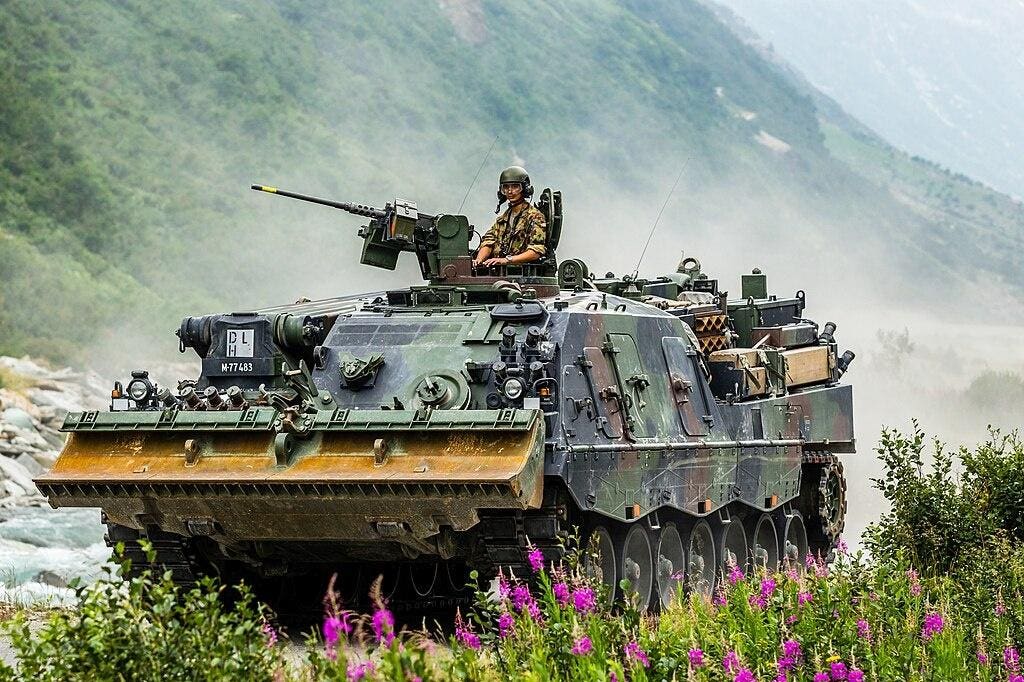The Ukrainian army has begun recovering some of the roughly 25 Western-made tanks, fighting vehicles and engineering vehicles it lost while trying to cross a minefield south of Mala Tokmachka on June 8.
The recovery effort, hinted at in a brief video that a Ukrainian engineering crew posted on social media on Saturday, tells us two things:
One, that Ukrainian forces have advanced far enough along the axis from Mala Tokmachka through Robotyne toward Tokmak that it’s safe for recovery teams to work.
Two, that the Ukrainians believe some of the two dozen or more vehicles they lost on June 8—including 17 M-2 infantry fighting vehicles, four Leopard 2A6 tanks, three Leopard 2R engineering vehicles and a Wisent engineering vehicle—are repairable.
Fixing up some of the IFVs, tanks and engineering vehicles retroactively would remedy some of the harm the Ukrainian 33rd and 47th Brigades suffered south of Mala Tokmachka on the fourth day of Ukraine’s long-anticipated southern counteroffensive.
The video of the recovery effort that appeared online on Saturday depicts the Ukrainian crew of a German-built Bergepanzer armored recovery vehicle—in essence, a military-grade, tracked tow-truck—preparing to haul from the site of the Mala Tokmachka minefield an American-made M-2 IFV. The M-2 appears to be only lightly damaged.
The 47th Brigade on June 8 abandoned at least 17 of its 99 M-2s plus three of its six Leopard 2Rs mineclearing tanks. The Leopard 2Rs and a Wisent mineclearer, the latter apparently belonging to the 33rd Brigade, were trying to clear lanes through potentially hundreds of 21-pound TM-62 anti-tank mines for the M-2s and some of the 33rd’s 14 Leopard 2A6s when something went wrong.
It’s possible the mineclearing tanks missed a few too many mines, triggering explosions that wrecked many of the lead vehicles and caused a pileup behind them that made the rest of the battlegroup an easy target for Russian artillery and helicopters.
In any event, the 33rd-47th battlegroup retreated with their wounded and dead. The brigades remained in the fight despite each losing around a fifth of their best vehicles. As Ukraine’s counteroffensive ground on along several sectors in Zaporizhzhia and Donetsk Oblasts, the 33rd and 47th ultimately found some way through or around the Mala Tokmachka minefield.
Attacking at night and at long range—conditions that favor the Leopard 2A6s’ long gun and high-end optics and the equally powerful optics and TOW anti-tank missiles on the M-2s—the brigades marched south a few miles and eventually reached the outskirts of Robotyne, where fighting continued on Sunday.
The front line now is far enough to the south that recovery crews can begin towing away the immobilized M-2s, Leopard 2A6s, Leopard 2Rs and other vehicles the Ukrainians left behind in that minefield. A damaged tank, possibly a T-72, also is visible in the Saturday video
When a Ukrainian photographer reached the site of the Mala Tokmachka debacle on or before June 24, TM-62 mines still were thick on the ground. Mineclearing crews, working methodically to achieve what the 33rd and 47th Brigades couldn’t do while under fire on June 8, over the next week presumably cleared enough of the mines that at least one Bergepanzer safely could roll in.
Expect Ukrainian forces to tow away and fix many of the damaged vehicles. While the United States recently pledged to Ukraine an additional 50 M-2s in order to make good recent losses, the Ukrainians as a matter of custom refuse to waste vehicles.
Consider the effort they put into modifying captured Russian T-62 tanks. The Ukrainians don’t have much ammunition for the T-62s’ 115-millimeter guns, so they instead are removing the 60-year-old tanks’ guns and transforming them into personnel carriers, fighting vehicles and engineering vehicles.
It’s especially urgent for Ukraine to restore as many damaged Leopard 2 tanks as possible. Ukraine’s foreign allies so far have pledged just 85 Leopard 2s to the war effort. In the month since the counteroffensive began, the Ukrainian army has written off at least two of the sophisticated tanks. Another five have suffered major damage, most after striking mines. Those seven destroyed and damaged tanks represent eight percent of the pledged Ukrainian Leopard 2 force.
Planners in Kyiv anticipated heavy vehicle losses—and prepared for a major ongoing recovery effort as a necessary function of a potentially months-long counteroffensive. In addition to acquiring hundreds of modern tanks and fighting vehicles for the counteroffensive corps, the Ukrainian government also asked its allies for scores of armored recovery vehicles.
Kyiv in recent months has taken delivery of 18 Bergepanzers from Germany and Canada, eight M-88 ARVs from the United States, Wisent ARVs from Denmark, NM217 ARVs from Norway and Challenger ARVs from the United Kingdom. That’s scores of Western-made ARVs to complement the ex-Soviet IMR ARVs the Ukrainians already had in their inventory.
While the Ukrainian army so far has managed to avoid falling into another trap like the one that ground up the 33rd-47th battlegroup on June 8, future losses are unavoidable. To reach the Black Sea and Sea of Azov from the current front line in southern Ukraine, Ukrainian brigades must advance at least 50 miles along most axes.
Every mile will cost them people and vehicles. Many of those vehicles merely will be damaged, not destroyed. They could return to the fight, but only after Ukrainian engineers do the hard work of clearing any nearby mines then hitching the immobilized vehicles to recovery vehicles and towing them off the battlefield.
It’s an effort that already is underway at the site of the Ukrainian army’s biggest recent defeat.
Read the full article here




